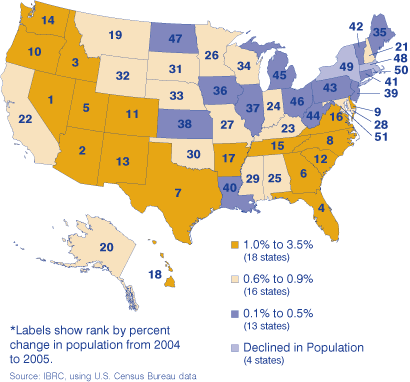Population Growth Matters: Latest Stats for Indiana
The Indiana economy thrives or dives because of the people who choose to live here. That choice may be the happenstance of being born here and desiring to stay, or a more deliberate one of choosing to locate here from another state or country. Such choices are often driven by opportunity as much as anything else—opportunities for education and jobs. Proximity to other places, family and friends can also drive such decisions (and proximity to the majority of major urban centers is a significant strength for Indiana). Ultimately, for whatever reason they have chosen to live in Indiana, our residents constitute our present and future.
Monitoring change in the size and movement of our population is an important barometer of well-being. Some of us monitor these changes as an insect might gauge the shifting sands, while most don't pay much attention. But the barometer is a good metaphor for population change, since it can presage more notable events, such as lackluster business attraction due to lack of workers. Some givens:
- Indiana's population growth historically goes from relatively stagnant to pretty good during economic booms—such as the manufacturing renaissance of the mid to late 1990s.
- Conversely, population growth in Indiana tends to become moribund during slow or recessionary economic times. Between 1980 and 1990, for example, Indiana's growth rate was less than 1 percent over that 10-year span, a time of downsizing in manufacturing and general economic hard times.
- When manufacturing jobs go away, some people leave Indiana for places such as Texas, California and Illinois. Indiana has shifted from a goods-producing to a service-providing economy (in terms of where the majority of jobs are among sectors), but jobs in the services sectors overall tend to pay less. This drives average wage and per capita personal income further below the national average.
- Business attraction has changed from attracting factories to attracting educated workers, who in turn attract often smaller but hopefully higher paying knowledge economy firms. Many states and communities are putting their emphasis on quality of life, showing their "cool quotient" to the young, mobile and better educated.
Indiana's growth rate since the 2000 census has slowed considerably. Figure
1 shows the most recent percent change in population. It is
a hard lesson in the zero-sum gain—even though we are still gaining
in population, the numbers aren't large enough that other states (such
as Washington, which now ranks as the 14th largest state) aren't overtaking
us on the size scale. Slow isn't fast enough and our small gains will
likely be most evident come time for the 2010 census and the resulting
apportionment of seats in Congress. Can this change? Of course. The
winds of economic change can indeed shift in our favor. Or more realistically,
development, attraction and retention efforts can take hold and shift
that barometer in the upward direction.
Figure 1: Percent Change in Population, 2004 to 2005

Click for image with state abbreviations
Carol O. Rogers, Associate Director
Indiana Business Research
Center, Kelley School of Business, Indiana University
